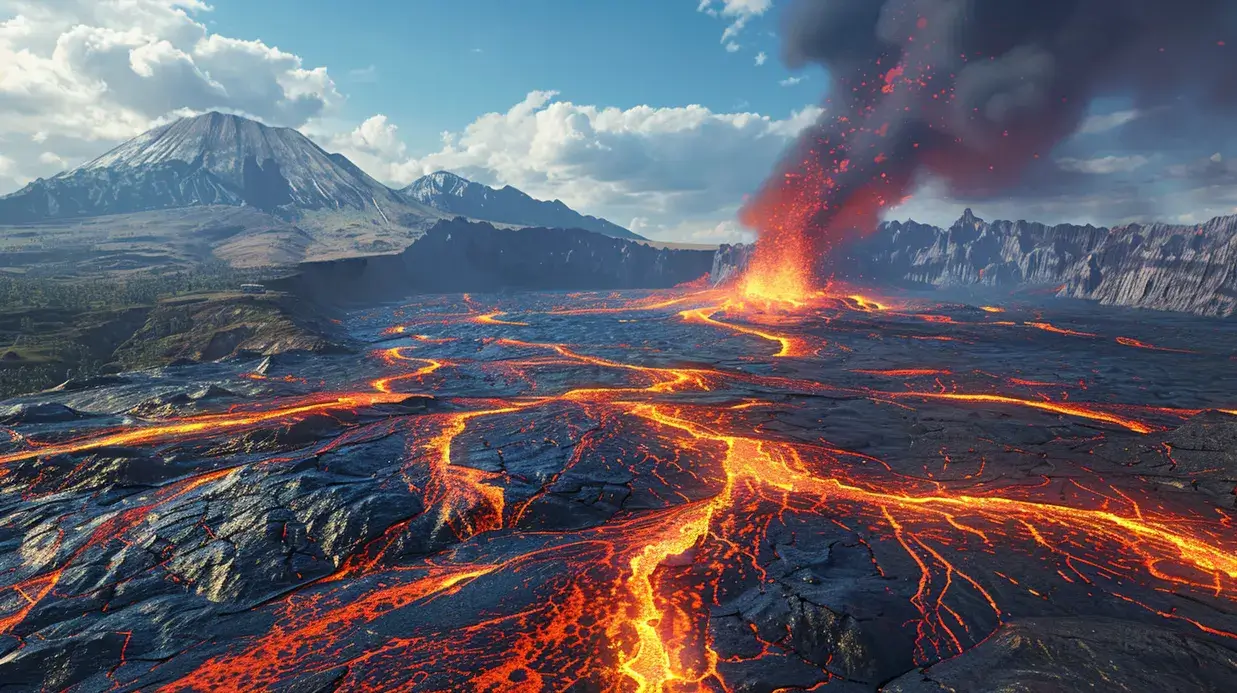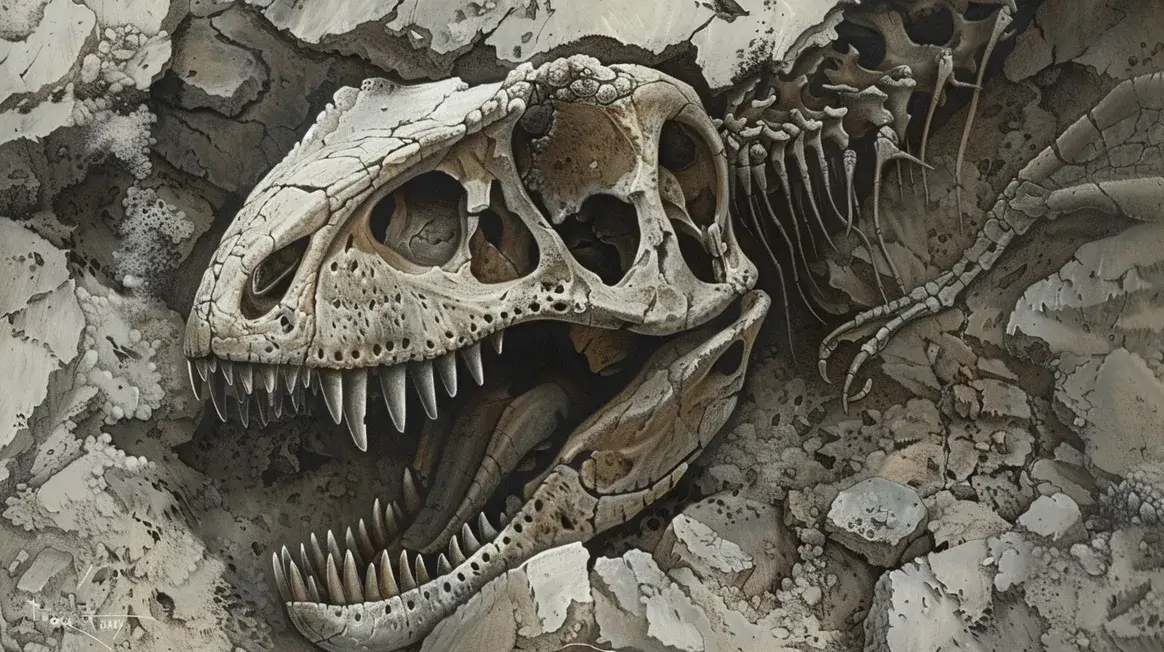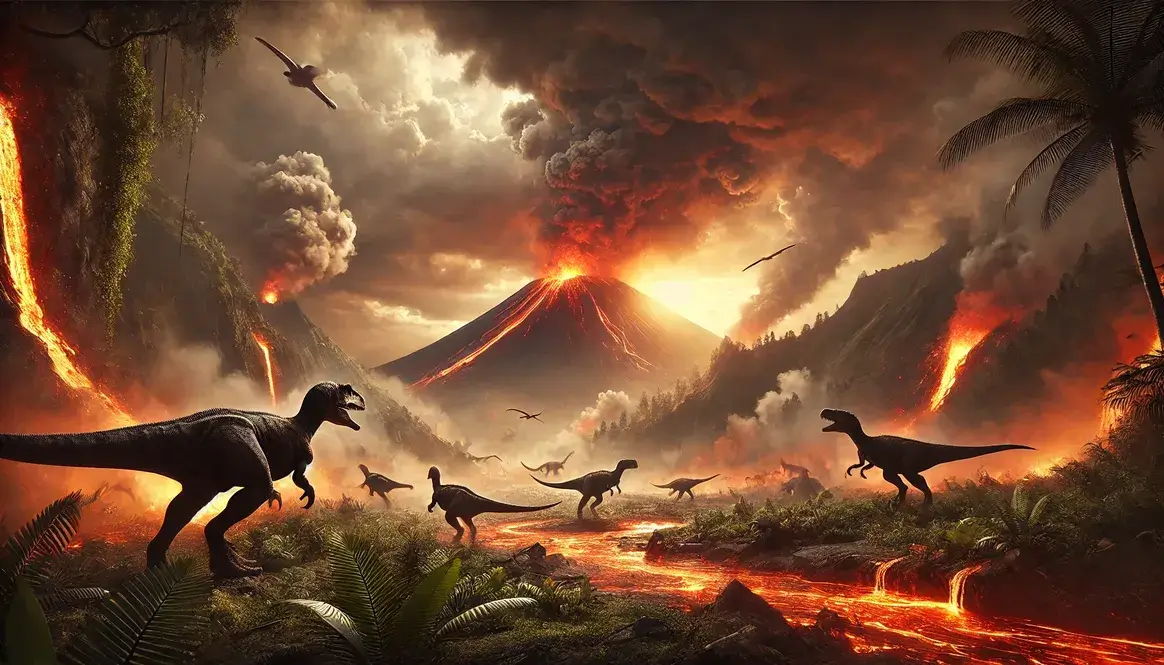Imagine being able to travel back in time to witness one of Earth’s largest volcanic events. That’s exactly what computer models of Deccan Traps allow scientists to do! The Deccan Traps, a massive area of volcanic rock in India, formed from enormous lava flows around 66 million years ago. These eruptions coincided with the time when dinosaurs went extinct, making them a crucial subject of study for paleontologists and geologists alike.
Computer modeling has become an essential tool for scientists trying to understand these ancient volcanic events. By using powerful computers and complex mathematical equations, researchers can create virtual versions of the Deccan Traps eruptions. These digital simulations help us see what might have happened millions of years ago, even though we can’t directly observe it today.
| Key Aspects of Computer Models of Deccan Traps | Insights Gained |
|---|---|
| Simulate eruption patterns and frequency | Understand the scale and duration of volcanic activity |
| Model environmental impacts | Estimate effects on atmosphere, climate, and oceans |
| Test extinction theories | Explore the role of volcanism in the K-Pg extinction |
| Reveal limitations in current knowledge | Identify areas for further research and data collection |
Computer Models of Deccan Traps: A Digital Time Machine
Computer models are like sophisticated video games that scientists use to recreate past events or predict future ones. In the case of the Deccan Traps, these models use information from rocks, fossils, and other geological evidence to build a digital version of the ancient Earth.
There are several types of models used to study the Deccan Traps:
- Eruption models: These simulate how lava flowed and spread across the landscape.
- Climate models: They show how volcanic gases and particles affected Earth’s temperature and weather patterns.
- Ocean chemistry models: These calculate changes in ocean acidity due to volcanic activity.
- Ecosystem models: They predict how plants and animals might have been affected by the eruptions.
These computer models are incredibly important for understanding prehistoric events like the Deccan Traps eruptions. They allow scientists to test different ideas about what happened and why. For example, researchers can use these models to see if the Deccan Traps eruptions could have caused enough environmental change to contribute to the extinction of the dinosaurs.
By combining different types of models, scientists can get a more complete picture of how the Deccan Traps might have affected the ancient world. This helps them piece together the puzzle of Earth’s past and better understand major events in our planet’s history.
Simulating Eruption Patterns
Computer models of Deccan Traps help scientists recreate the massive volcanic eruptions that occurred millions of years ago. These simulations provide valuable insights into how the Deccan Traps formed and their potential impact on the ancient environment.
Modeling Lava Flow and Volume
One of the most impressive aspects of the Deccan Traps eruptions was the sheer amount of lava they produced. Scientists use computer models to estimate just how much lava flowed and how far it spread. These models take into account:
- The shape of the land before the eruptions
- The chemical composition of the lava
- The temperature and viscosity of the molten rock
By inputting this information into their simulations, researchers can create virtual recreations of the lava flows. These digital models show how the lava might have moved across the landscape, filling valleys and creating vast plateaus.
But it’s not just about the amount of lava. These models also help scientists understand how long the eruptions lasted and how intense they were. Some simulations suggest that the Deccan Traps eruptions occurred in pulses, with periods of intense activity followed by quieter times.
| Model Parameter | What It Tells Us |
|---|---|
| Lava volume | Total amount of volcanic material erupted |
| Flow rate | How quickly lava spread across the land |
| Eruption duration | How long each eruptive phase lasted |
| Lava composition | Temperature and behavior of the lava flows |
Reconstructing Eruption Frequency
Another crucial aspect that computer models help with is figuring out how often the Deccan Traps eruptions occurred. This is important because the frequency of eruptions can tell us a lot about their potential impact on the environment.
To estimate eruption frequency, scientists use models that incorporate:
- Geological evidence from rock layers
- Radiometric dating of volcanic rocks
- Patterns observed in modern volcanic systems
These models suggest that the Deccan Traps didn’t form from one continuous eruption. Instead, they likely resulted from a series of eruptions spread out over hundreds of thousands of years. Some models indicate that there might have been periods of more intense activity, particularly around the time of the dinosaur extinction.
Understanding the long-term volcanic activity of the Deccan Traps is crucial for assessing their environmental impact. If the eruptions were spread out over a long time, the Earth might have had chances to recover between episodes. But if they were clustered together, the cumulative effect could have been more severe.
By simulating different eruption scenarios, scientists can test various hypotheses about how the Deccan Traps might have affected the ancient world. This helps them piece together the complex puzzle of Earth’s history and the events that shaped our planet.
Environmental Impact Simulations
Computer models of Deccan Traps don’t just show us how the lava flowed; they also help scientists understand how these massive eruptions might have changed the world around them. These simulations give us a glimpse into the ancient environment and how it reacted to such large-scale volcanic activity.
Atmospheric Changes
When volcanoes erupt, they don’t just spew out lava. They also release huge amounts of gases and tiny particles into the air. Computer models help scientists estimate just how much of these materials the Deccan Traps eruptions might have pumped into the atmosphere.
Here’s what these models typically look at:
- Carbon dioxide levels
- Sulfur dioxide emissions
- Ash and dust particles
By simulating the release of these substances, researchers can estimate how they might have affected the Earth’s atmosphere millions of years ago. One of the most important things these models help us understand is how the Deccan Traps eruptions might have changed the climate.
Many simulations suggest that the gases and particles from the eruptions could have had a significant impact on global temperatures. Here’s a simplified breakdown of what the models show:
| Volcanic Output | Short-term Effect | Long-term Effect |
|---|---|---|
| Ash and dust | Cooling | Minimal |
| Sulfur dioxide | Significant cooling | Minimal |
| Carbon dioxide | Minimal | Warming |
As you can see, the effects could have been complex, with some factors causing cooling and others leading to warming over different timescales.
Ocean Chemistry Alterations
The impacts of the Deccan Traps eruptions weren’t limited to the air. Computer models also help scientists understand how these volcanic events might have affected the oceans.
One of the key things these models simulate is changes in ocean acidity. When volcanoes release carbon dioxide, much of it gets absorbed by the oceans. This process makes the water more acidic, which can have serious consequences for marine life.
Computer simulations of the Deccan Traps suggest that the eruptions could have led to significant ocean acidification. These models take into account:
- The amount of carbon dioxide released by the eruptions
- How quickly the gas was absorbed by the oceans
- The buffering capacity of seawater (its ability to resist changes in pH)
The results of these simulations paint a concerning picture for ancient marine ecosystems. Increased acidity could have made it difficult for many organisms to build and maintain their shells or skeletons. This might have affected everything from tiny plankton to larger creatures like ammonites and marine reptiles.
By modeling these changes, scientists can better understand the potential role of the Deccan Traps in the marine extinctions that occurred around the same time as the dinosaur extinction. These simulations provide valuable insights into how large-scale volcanic activity can have far-reaching effects on Earth’s ecosystems, both on land and in the sea.
Climate Impact Models
Computer models of Deccan Traps play a crucial role in helping scientists understand how these massive volcanic eruptions might have affected Earth’s climate. These simulations allow researchers to explore both the immediate and long-term impacts of the eruptions on global weather patterns and temperatures.
Short-term Climate Effects
When it comes to short-term climate changes, computer models focus on the immediate aftermath of major eruptions. These simulations help scientists visualize what might have happened to the Earth’s climate in the weeks, months, and years following intense volcanic activity.
One of the key phenomena these models explore is the potential for a volcanic winter. This occurs when volcanic ash and gases, particularly sulfur dioxide, are injected high into the atmosphere, forming a haze that reflects sunlight back into space.
The models typically show:
- A rapid drop in global temperatures
- Changes in precipitation patterns
- Altered wind circulation
For example, some simulations suggest that a single large eruption from the Deccan Traps could have caused global temperatures to drop by several degrees Celsius for a few years. This sudden cooling could have had dramatic effects on plant and animal life, potentially contributing to the stress on ecosystems already facing other challenges.
Long-term Climate Trends
While short-term effects are important, the long-term climate impacts of the Deccan Traps eruptions are equally fascinating. Computer models help scientists understand how the cumulative effect of multiple eruptions over thousands of years might have shaped the Earth’s climate.
These long-term simulations take into account:
- The total volume of greenhouse gases released
- Changes in the Earth’s ability to reflect sunlight (albedo)
- Feedback loops in the climate system
| Time Scale | Dominant Climate Driver | Potential Impact |
|---|---|---|
| Years | Sulfur aerosols | Cooling |
| Decades | Carbon dioxide | Warming |
| Centuries | Combined effects | Complex patterns |
Many models suggest that while individual eruptions might have caused short-term cooling, the overall trend over thousands of years could have been towards warming. This is because volcanoes release large amounts of carbon dioxide, a greenhouse gas that can persist in the atmosphere for long periods.
The long-term warming trend simulated by these models is particularly interesting when considering the potential role of the Deccan Traps in the end-Cretaceous extinction event. Some scientists argue that this gradual warming, combined with other environmental stresses, could have contributed to the decline of many species, including dinosaurs.
By simulating these long-term trends, computer models of Deccan Traps provide valuable insights into how large-scale volcanic activity can influence global climate over extended periods. This helps scientists better understand the complex interplay between volcanism and climate change throughout Earth’s history.
Limitations and Challenges of Deccan Traps Models
While computer models of Deccan Traps provide valuable insights, they’re not without their limitations. Scientists face several challenges when trying to recreate events that happened millions of years ago using modern technology.
Data Uncertainties
One of the biggest hurdles in creating accurate models of the Deccan Traps is the limited geological data available. After all, we’re dealing with events that occurred roughly 66 million years ago! Here’s why this poses a challenge:
- Incomplete rock record: Over millions of years, erosion and tectonic activity have altered or destroyed some of the original Deccan Traps formations.
- Limited samples: Scientists can only study a fraction of the remaining rocks, which may not represent the entire range of volcanic activity.
- Altered materials: Chemical and physical changes over time can affect the information we can gather from rocks and minerals.
These data limitations can significantly impact model accuracy. For example, if we don’t have precise information about the timing of eruptions, it’s harder to model their potential environmental impacts accurately.
Uncertainties in the data can lead to a range of possible outcomes in the models. This is why scientists often run multiple simulations with different parameters to see how changes in the input data affect the results. While this approach helps account for uncertainties, it also means that the models can’t always provide definitive answers.
Computational Constraints
Creating computer models of massive geological events like the Deccan Traps eruptions is no small feat. These simulations involve incredibly complex processes occurring over vast areas and long time periods. This complexity presents several challenges:
- Processing power: Even with modern supercomputers, some simulations can take weeks or months to run.
- Data storage: High-resolution models generate enormous amounts of data that need to be stored and analyzed.
- Model resolution: There’s often a trade-off between the level of detail in a model and the time it takes to run.
To manage these constraints, scientists have to make decisions about what to include in their models and what to simplify. For instance, a model might focus on large-scale lava flows but not include detailed simulations of individual eruptions.
| Model Aspect | High Detail | Low Detail |
|---|---|---|
| Advantages | More accurate results | Faster processing |
| Disadvantages | Requires more computing power | May miss important small-scale effects |
Balancing detail and computational power is a constant challenge. Scientists must decide which processes are most important to model in high detail and which can be simplified without significantly affecting the results.
Despite these limitations, computer models of Deccan Traps continue to improve as technology advances and our understanding of geological processes grows. By acknowledging and working within these constraints, scientists can still gain valuable insights into how these massive eruptions might have affected ancient life and shaped the course of Earth’s history.
Improving Model Accuracy
As technology advances and our understanding of ancient geological events grows, scientists are constantly working to improve the accuracy of computer models of Deccan Traps. This ongoing refinement helps us gain a clearer picture of how these massive eruptions might have impacted the world millions of years ago.
Incorporating New Data
New geological discoveries play a crucial role in refining computer models of the Deccan Traps. Every time scientists uncover new evidence or develop better techniques for analyzing existing data, they can update their simulations to reflect this improved understanding.
Some ways new data improves models include:
- Better dating techniques: More precise methods for determining the age of rocks help scientists pinpoint when specific eruptions occurred.
- Improved chemical analysis: Advanced tools allow researchers to analyze the composition of volcanic rocks in greater detail, providing insights into eruption conditions.
- New fossil discoveries: Fossils found in layers associated with the Deccan Traps can provide clues about the environmental conditions at the time of the eruptions.
For example, recent studies of mercury in fossils have provided new insights into volcanic activity around the time of the dinosaur extinction. This type of discovery can be incorporated into computer models to improve their accuracy.
Ongoing research is vital for enhancing these simulations. As scientists continue to study the Deccan Traps and related geological features, they gather more data points that can be fed into the models. This iterative process of discovery and model refinement helps create increasingly accurate representations of these ancient events.
Advanced Computing Techniques
Alongside new geological data, advancements in computing technology are revolutionizing how scientists model the Deccan Traps. These new techniques are enabling more detailed and accurate simulations than ever before.
Some exciting developments include:
- Machine learning algorithms: These can help identify patterns in complex geological data that humans might miss.
- Cloud computing: By harnessing the power of distributed computing networks, scientists can run more complex simulations faster.
- Virtual reality (VR) visualization: VR technology allows researchers to ‘walk through’ their simulations, providing new perspectives on the data.
| Technology | Benefit to Modeling |
|---|---|
| Machine Learning | Identifies subtle patterns in data |
| Cloud Computing | Enables more complex, faster simulations |
| VR Visualization | Provides new ways to interact with model results |
These advanced techniques are opening up new possibilities for studying how volcanoes affect evolution and shape Earth’s history.
Looking to the future, we can expect even more accurate Deccan Traps simulations. As computing power continues to increase and new modeling techniques are developed, scientists will be able to create more detailed and comprehensive models. These improved simulations might help resolve ongoing debates about the role of the Deccan Traps in the end-Cretaceous extinction event and provide new insights into how large-scale volcanism impacts global climate and ecosystems.
By combining cutting-edge technology with meticulous geological research, scientists are continually enhancing our understanding of this crucial period in Earth’s history. Each improvement in computer models of Deccan Traps brings us closer to unraveling the mysteries of our planet’s past.
Computer Models and Extinction Theories
Computer models of Deccan Traps play a crucial role in the ongoing debate about what caused the extinction of dinosaurs and many other species at the end of the Cretaceous period. These simulations help scientists test different theories and compare the potential impacts of volcanic activity with other factors, like the famous asteroid impact.
Linking Volcanic Activity to the K-Pg Extinction
Scientists use computer models to explore how the Deccan Traps eruptions might have contributed to the mass extinction that occurred about 66 million years ago. These models simulate various aspects of the eruptions and their potential effects on the environment:
- Release of greenhouse gases
- Emission of sulfur dioxide and other pollutants
- Changes in global temperature and rainfall patterns
- Alterations in ocean chemistry
By running these simulations, researchers can estimate how severe the environmental changes might have been and whether they could have been enough to cause widespread extinctions.
One interesting aspect of these models is how they compare the effects of volcanism with those of the asteroid impact. Here’s a simplified comparison:
| Factor | Volcanic Model | Asteroid Model |
|---|---|---|
| Duration | Long-term, gradual changes | Sudden, catastrophic event |
| Global cooling | Moderate, fluctuating | Severe, rapid |
| Greenhouse effect | Strong, long-lasting | Initially masked by dust |
| Ocean acidification | Gradual increase | Rapid, severe increase |
These comparisons help scientists understand how different factors might have worked together to create the conditions that led to the extinction of dinosaurs and many other species.
Debating the Deccan Traps’ Role
The results from computer models of Deccan Traps have fueled an ongoing debate about the primary cause of the K-Pg extinction. Some scientists argue that the models show the volcanic eruptions could have been the main driver of the extinction, while others maintain that the asteroid impact was the decisive factor.
Here’s how model results contribute to this debate:
- Supporting volcanic hypothesis: Some models suggest that the long-term effects of the Deccan Traps eruptions, such as global warming and ocean acidification, could have stressed ecosystems to the breaking point even before the asteroid hit.
- Challenging volcanic hypothesis: Other simulations indicate that while the Deccan Traps had significant environmental impacts, they might not have been severe enough on their own to cause a mass extinction.
- Combination theories: Many scientists now use these models to explore how the Deccan Traps and the asteroid impact might have worked together. For example, some propose that the volcanic activity weakened ecosystems, making them more vulnerable to the sudden shock of the impact.
This scientific discussion is far from over. As computer models become more sophisticated and new geological evidence comes to light, our understanding of the K-Pg extinction continues to evolve. The debate about whether the Deccan Traps killed the dinosaurs remains active, with computer models playing a central role in testing and refining different hypotheses.
By simulating these ancient events, scientists can better understand the complex interplay of factors that shape Earth’s history. While we may never know with absolute certainty what caused the extinction of the dinosaurs, computer models of Deccan Traps are helping us get closer to unraveling this enduring mystery.









